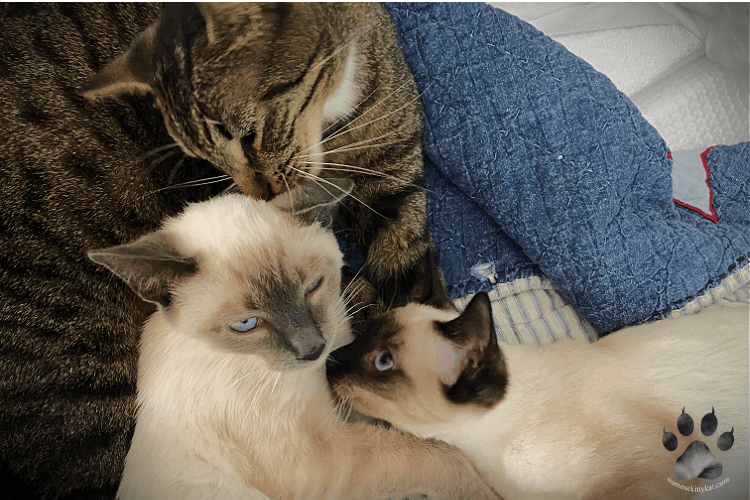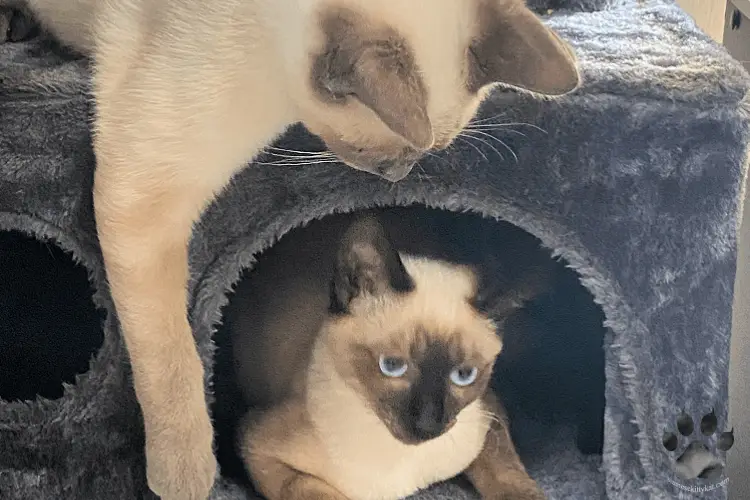I didn’t have much trouble making my two Siamese cats, Batman and Robyn, get along as they’ve been together since day one. But sometimes one of them would be moody and it can be difficult to know how to make them get along.
Luckily, there are a few steps we can take to help our cats become friends. I outlined 19 surefire ways to make your Siamese cats get along in this article. You’ll soon have two happy cats who enjoy each other’s company with these tips in mind.
Is a Siamese a Territorial Cat Breed?
Siamese cats have a reputation for being more territorial than many other breeds. Often described as sassy and strong-willed, these cats seek out mischief and demand their owner’s attention.
The degree to which this trait manifests in any Siamese cat depends on several factors.
- The origins of the Siamese cat can be traced back to Southeast Asia in the 14th century. These cats were bred as companion animals in Siam, now known as Thailand. Learn more about their history here: Origin of Siamese Cats
These cats, as companions, had to be territorial to protect their homes from intruders. This trait has been passed down through generations. Thus, modern Siamese cats have a natural instinct toward territorial behavior.
- Another factor is a Siamese cat’s environment. Cats living in an unstable environment are more protective of their space than those who live in comfortable homes.
Siamese cats will also show signs of possessiveness if your family has multiple pets. Additionally, your cat might assert dominance if a new pet enters the household without proper introduction.
- Siamese cats are intelligent and need mental stimulation. They may become frustrated and act out without proper stimulation. They may attack other animals or humans who enter their territory uninvited.
How Long Does it Take for Cats to Get Used to Each Other?
It can take anywhere from a few weeks to a few months for cats to develop relationships with one another.
Their personalities primarily influence how quickly cats learn to get along. Some cats are outgoing and social, while others are more reserved and shy.
Some felines may also need extra time if they were exposed to trauma early in life or had negative experiences with other cats.
It’s best to allow two cats some space to become accustomed to each other’s presence during their first meeting. This helps build the foundation for their friendship and make their interactions successful.
Provide lots of positive reinforcement whenever the cats show friendly behaviors towards one another. Offering treats or providing toys can also go a long way in helping the two cats become friends.
What are the Best Ways to Get Your Siamese Cats to Get Along With Each Other?

The first step in getting your cats to get along is to identify what the conflict is about. Think about what causes arguments between your furry friends.
Do they squabble over food or water? Do they compete for attention? Do they fight over territory or resources?
You can start to address the problem once you have identified what triggers their conflict.
There are some tips you can use to help your cats get along.
1. Start early introduction
It’s best to introduce kittens early on, so they can learn to accept each other as part of their feline family. This should be done with care and caution so that neither of them feels threatened or overwhelmed.
Keep them separated when introducing the new kitten. Give them time to adjust and become comfortable with each other’s presence.
2. Provide separate areas
Lack of personal space is often a major factor in conflicts between cats.
Thus, provide enough space for each cat. This means providing them with separate litter boxes and feeding areas. This will reduce competition over resources and help them feel less threatened by each other.
It also helps if they have their own beds or perches where they can sleep undisturbed. Provide different cat trees or scratching posts for them as well.
3. Feed them separately
Place the food bowls far away enough from each other, so they won’t interact while eating, but still close enough where they can smell each other’s presence.
This will create familiarity between the felines without forcing them into a direct confrontation as they eat their meals.
4. Encourage playtime
Make sure your Siamese cats have plenty of opportunities to play together. Playing helps them burn off excess energy. It also builds positive associations between them.
Try setting aside a few minutes each day for some supervised playtime.
Batman and Robyn enjoys playing together in the bath tub and have always gotten along. When they were kittens though, their was a brief time when their playtime ended in a catfight. I made sure to intervene everytime I hear one of them cry while playing. The fighting stopped after a few interventions.
5. Invest in some good toys
Invest in some good quality toys to get your Siamese cats to play together. There are different types of toys on the market designed for cats. Take some time to look around and find the ones your kitties will enjoy.
Be sure to provide interactive toys such as feather teasers and laser pointers. Make sure to offer a variety of toys, so they don’t get bored with the same ones day after day.
Providing multiple toys allows your cats to explore their natural hunting instincts together. This helps build trust between them over time.
6. Spend quality time with each cat individually
It’s important to give each cat equal amounts of love and attention. Siamese cats are social creatures and thrive on companionship. It can lead to jealousy and conflict if one cat feels neglected.
By giving them equal affection, you’re letting them know they are both important to you. Here are fun ways to spend quality time with your Siamese cats: Ways to Bond with Your Siamese Cat
7. Familiarize them with each other’s scent
One way is to exchange bedding between the two cats. Another is to rub a towel on each cat and place the towel in the other cat’s sleeping area.
Taking these steps will help them get used to each other’s smells. Thus, they will feel more comfortable around each other and less like strangers.
8. Minimize territory marking
Siamese cats may mark their territory with urine or scratches as a way of claiming an area as theirs. You should provide enough litter boxes and scratching posts for both cats. This will minimize their marking behavior. They don’t feel the need to fight over resources this way.
9. Ensure that the environment is calm and peaceful
The presence of loud noises or chaotic environments can cause stress and anxiety in cats. This leads them to become aggressive towards each other.
Try to reduce noise levels from music or television as much as possible. Provide plenty of comfort items like pillows and blankets for both cats, so they feel secure in their surroundings.
10. Monitor interactions
Pay attention to body language cues such as laid back ears or tail twitching. These could be signs that something isn’t right between them.
Immediately separate them if you see any warning signs. Avoid physical discipline as it can encourage further aggression from your pets.
11. Use positive reinforcement
Positive reinforcement training is an effective way of teaching your cats acceptable behaviors.
Start by rewarding them when they interact positively with each other. Give them treats or compliment them when they look at each other calmly or touch noses instead of fighting.
Doing this regularly will teach them that being together is a positive experience. This will encourage them to continue interacting in a friendly manner rather than engaging in aggressive behavior.
12. Spay or neuter your cats
Spaying or neutering is one of the most effective ways of reducing aggression between your cats. It may also reduce their urge to mark their territory.
A cat that has been spayed or neutered will be less likely to roam around looking for mates. Thus, can help prevent unwanted pregnancies from occurring.
After all of my three cats, Batman, Robyn and Boots, are spayed/neutered, we had a more peaceful home ever since.
13. Consider using pheromone diffusers or sprays in different areas of your home.
Pheromones are chemicals cats release when they’re feeling content. Products like Feliway mimic these calming scents and can help promote harmony between cats.
14. Provide hiding places
Give each cat a few appropriate hiding places where they can relax. This will allow them time apart from one another.
A few examples of great hiding places include a cozy bed or box, an enclosed shelf or even behind furniture.
15. Re-introduce your cats correctly
This process should start with creating visual barriers between your cats. This includes separating rooms with baby gates or using tall cat trees.
Let them get used to seeing and smelling each other from a distance before allowing them physical contact.
16. Provide ample opportunities for socialization outside the home
This is also key in helping your Siamese cats get along better together indoors. Taking them out on walks together may help reduce stress levels among both cats.
17. Encourage mutual grooming
Mutual grooming is another way that felines show affection towards one another. It not only strengthens social bonds between cats. It also helps reduce stress levels, which can contribute to better relationships overall.
To encourage this behavior, start by brushing both cats at the same time or brushing one at a time. Say positive phrases such as “good friends” or “lovely kittens”.
18. Avoid sudden changes in the environment
Make sure you keep your cat’s daily routine consistent and predictable, so they don’t become overwhelmed or confused. Try not to rearrange furniture or introduce new people or pets into the home. These can further disrupt their sense of security within their environment.
19. Consider consulting a professional
Consult with a veterinarian if you find yourself struggling despite trying all these tips. Sometimes, underlying medical issues may be causing conflict between pets. A vet may be able to recommend medications which could help reduce anxiety and stress levels between the pair.
How Do You Know if Two Cats Will Get Along?

- One of the most obvious indicators that two cats have bonded is if they engage in head-butting. Headbutting, also known as “bunting,” is a friendly gesture cats use to show affection and acceptance towards one another.
Cats who rub their heads and cheeks against each other are leaving behind a scent that tells them this is a trusted friend.
- Another sign of a potential friendship between two cats is grooming. Mutual grooming is common among cats who have bonded. It indicates they accept each other’s presence. Your cats have likely formed a comfortable relationship with each other if you notice one licking the fur of the other.
- Your cats appear relaxed in each other’s presence and move slowly around each other. Both felines still need to build trust if either cat appears agitated.
- Another indicator is playtime behavior. Watch how your cats interact with toys and items in their environment. Your cats have a strong connection forming between them if they show interest in playing with each other.
- Your cats are snuggling up together for a nap. Cats won’t usually share sleeping spaces with just anyone. They do this only with those whom they trust and feel safe around. Thus, your cats have formed an inseparable bond if you see them snoozing side by side.
- Another sign is when they touch noses in greeting. It’s a sign of mutual trust and understanding between them. It is a good indication that they will live together peacefully.
I have two Siamese cats, Batman and Robyn, who are best friends. One thing that makes them special is how well they get along. You can find them curled up in each other’s fur from morning till night. They play tag around the house sometimes.
I realized how much closer my cats had grown. It started with small things – one would groom the other’s fur when they were little. There were many more signs they enjoyed each other’s company. They rub against each other and even share food bowls during meals.
How Do You Know If Two Cats Won’t Get Along?
There are certain behaviors and signs you should look out for to determine if two cats won’t get along.
- One cat avoids the other by actively steering clear and refusing to come close. Cats have a natural instinct to stay away from something unfamiliar.
Thus, it’s time to reconsider their living arrangements if, after several weeks, there is still no sign of acceptance from either of your cats.
- Your cats may have their tails swishing back and forth or standing straight up with fur raised. This could mean that one cat is feeling threatened by the other.
- Flattened ears, hissing, growling, or wide eyes show aggression between cats who do not get along.
- One of your cats begins chasing the other around or attempting to attack physically. This occurs because one has viewed the other as an intruder on their territory and wants them gone.
- Vocalizations often tell us a lot about how two cats feel toward each other. A happy meow could mean one cat was saying hello or greeting another. However, your cat is feeling scared or threatened by another feline if he starts yowling loudly.
Is it Possible for Two Cats to Never Get Along?
It’s possible for two cats to never get along. This can happen for many reasons.
Some of the most common causes include:
Some cats don’t like being around others – even those of their own species. Let them remain separate unless you plan on investing in separate accommodations where they won’t come into contact with one another (e.g., having multiple rooms).
Another factor influencing whether cats can get along is their environment and how it’s set up. There is tension between cats if there are few resources, such as food bowls or litter boxes. Similarly, cats will fight each other if there isn’t enough space for them.
How Do You Tell if Cats Are Fighting or Playing?

Cats are social animals, and they love to engage in active play. However, you must be able to tell the difference between a fight and a playful encounter. Pay close attention to their body language to understand if they are fighting or playing.
Cats playing will usually have less aggressive postures. These include arching their backs and holding their bodies lower. They also tend to take turns rather than attacking one another at the same time. Cats make chattering noises, purr, or meow softly when they play.
Your cats might also “play bite.” Play bites will usually not break the skin or draw blood. Real bites during fights can cause serious damage and injury.
Cats that are fighting tend to exhibit more aggressive behaviors. The physical contact between cats is much more intense. Cats may bite, scratch, hiss, or growl at one another. Cats may also puff up their fur to appear larger and more intimidating.
Another way to tell if cats are fighting or playing is by looking at how they interact afterward. Cats fighting will avoid one another afterward, or one cat may try to flee from the other. If your cats won’t stop fighting, here are effective ways to break them up: Effective Ways to Break Up a Cat Fight
On the other hand, two cats who have been engaging in playtime activities might nap together afterward. They will also groom one another as a sign of affection and friendship.
Conclusion
Siamese cats may not always be best friends with their feline companions. However, there are several methods you can use to ensure your cats get along.
Make sure each cat has their own space and that they can access food, water, and litter boxes independently. Additionally, provide plenty of opportunities for playtime.
Pay attention to the body language of your cats and intervene if disputes arise between them. You will create a harmonious environment where your Siamese cats can coexist soon.
We gathered all the health tips tailored toward maintaining your Siamese cat’s optimal well-being. Check it out here: Siamese Cat Health: A Complete Guide
Be the Siamese Cat expert you always wish to be! From color points to similar cat breeds, discover everything you need to know about their unique charm and characteristics in our comprehensive guide: Siamese Cat Breed: Types, Color Points and Comparison to Other Cat Breeds
Want to adopt a Siamese cat? Here’s everything you need to know about adopting this unique feline breed: Siamese Cat Rescue and Adoption.

